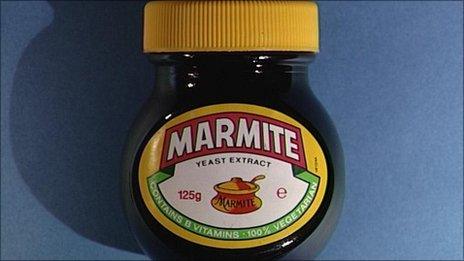Marmite: Ten things you'll love/hate to know
- Published

Marmite - you either love it or hate it, the makers say
Marmite has been in the news after it was reported that Denmark had banned it.
In fact it can be sold but only if a licence is granted by the Danish Veterinary and Food Administration. Here are 10 things you maybe did not know about the "love it or hate it" spread.
1. It was invented by accident. In the late 19th Century a German scientist, Justus Liebig, discovered brewer's yeast could be concentrated, bottled and eaten. In 1902 the Marmite Food Company was founded in Burton-on-Trent, Staffordshire, where the raw material was readily available from the town's brewers. The original recipe contained salt, spices and celery. Later folic acid, vitamin B12, thiamin and riboflavin - vitamins which occur naturally in some foods - were added in high concentrations.
2. Marmite won two world wars. OK, that's not strictly true. But it was included in soldiers' rations in World War I and, along with bully beef, Spam and condensed milk, it was popular among civilians and the military between 1939 and 1945. In 1999 the company sent extra supplies to homesick British peacekeeping troops in Kosovo.
3. Marmite is French. Well, the name comes from the name of a French casserole dish called a marmite (pronounced Marmeet). In the Normandy port of Dieppe, a popular fish stew is known as a Marmite Dieppoise. Ever since the 1920s the red and yellow label on the jar has had a picture of a marmite on it.
4. Jail staff are not keen on it. There's an urban myth that it is banned in British prisons because it can be used to make hooch. In 2002 it was reported that inmates at Featherstone jail, near Wolverhampton, were using it, along with fermented fruit and vegetables, to make moonshine. In 2009 it was reported that inmates at Dartmoor prison were cooking up a brew called a Marmite Mule., external But a Prison Service spokesman said on Wednesday it was not banned as it could not be used to make any alcoholic drinks.
5. There's more than one Marmite. In New Zealand and Australia the Sanitarium Health and Wellbeing company sells Marmite, external but it has added caramel and sugar to its version, which obviously gives it a sweeter taste. Sanitarium bought the rights to use the brand name back in 1908.
6. Marmite does not just come in jars. Other products in the range which you might also hate are Marmite Mini Cheddar Bites, Marmite crisps, Marmite jumbo rice cakes and Marmite flavoured oven-baked cashew nuts.
7.Marmite used to be made in London. The product became so popular that the company's factory in Burton-on-Trent could not keep up so they converted a former brewery in Vauxhall, south London to create a second plant. One resident of the area recalls on a local history blog:, external "When I was a kid we lived near the Marmite factory at Vauxhall. The smell from the factory was disgusting! People living close by applied to have their rates reduced because of the stench (they failed of course)." The factory closed in 1967.

Since last year the good folk of Burton-on-Trent have been living with this Marmite jar sculpture
8. A sculpture has been built in Marmite's honour. Last year Unilever, the conglomerate which owns the brand, spent £15,000 on a sculpture of a Marmite jar. The sculpture, nicknamed Monumite, now takes pride of place next to the main library in Burton-on-Trent.
9. Marmite may keep away mosquitoes. Several newspapers, including the Guardian, the Sun and the Daily Telegraph, have claimed the yeasty spread to be the perfect defence against mozzies.
10. It's good for you. Despite the Danish doubts about the effects on people's health, Marmite could actually be good for you. Nutritionist Melanie Brown says: "Marmite plays such a useful part in many people's diet, and it's incredibly useful for older people who are short in vitamin B-12. It's full of folic acid, and there's lots of evidence that many women, young women of child-bearing age are deficient in folic acid."
- Published25 May 2011